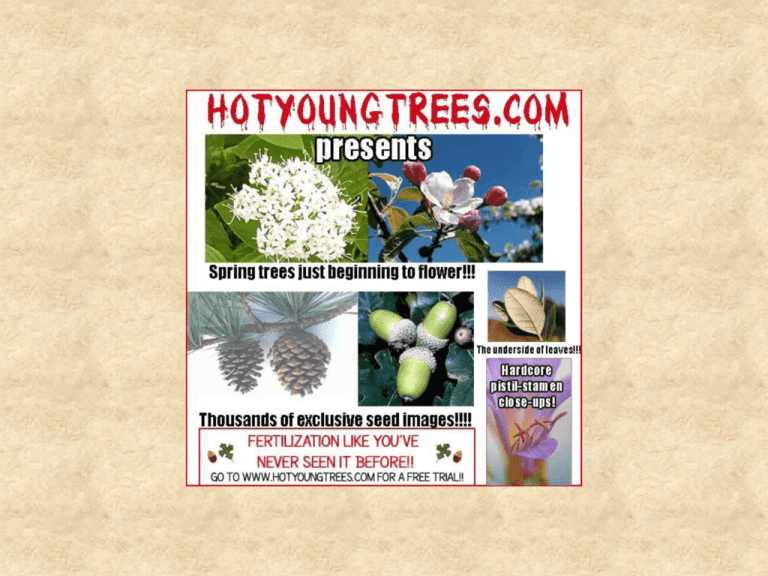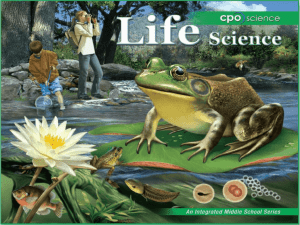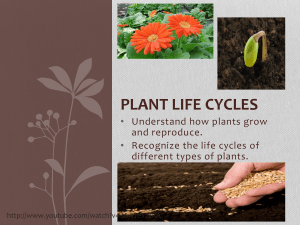Lecture - Chapter 43 - Seeds, Fruits, and Dispersal
advertisement

Chapter #43 – Plant Reproduction • 43.4 How Do Fruits and Seeds Develop? • 43.5 How Do Seeds Germinate and Grow? • 43.6 What Are Some Adaptations for Pollination and Seed Dispersal? Fruits and Seeds • Get a paper ready for thinking questions to turn in From Ovary to Fruit • The ovary of the flower contains the ovules. • As fertilized ovules develop into seeds, the ovary wall develops into the fruit. • In science, the term “fruit” refers to a mature, ripened ovary that contains seeds. Types of Dry Fruits Capsule (Poppy) Legume (Bean pod) Silique (Money Plant) Achene Follicle (Columbine) (Sunflower) Nut (Hazelnut) Types of Fleshy Fruits Drupe (Peach) Berry (Tomato) Pome (Apple) Aggregate (Strawberry) Pepo (Cucumber) Multiple (Pineapple) Fruit Dispersal • The form of the fruit gives clues about its dispersal. • Small, dry fruits with “wings” or “parachutes” may be wind-dispersed. Fleshy fruits are often animal dispersed. Explosive fruits can fling seeds away. Floating fruits may be water dispersed. How are these Fruits Dispersed? Dandelion Coconut Maple Cocklebur Jewelweed A Thinking Question? • Why must fruits be dispersed away from the parent plant? Seeds Seed Dormancy • As seeds mature, they enter a period of dormancy. – Suspended growth and development. – Lowered metabolic rate. – Resistance to adverse environmental conditions. Seed Dormancy • Conditions that break dormancy vary among plant species. – Some germinate as soon as the environment is suitable (adequate moisture and temperature). • Conditions that break dormancy vary among plant species. – Others have additional requirements: • Initial drying (seeds within fleshy fruits) • Exposure to prolonged cold (seeds of temperate and arctic plants). • Disruption of seed coat . Seed Dormancy • Seeds can remain dormant in the soil for long periods of time. Dormancy ensures that seeds only germinate when conditions are optimal. • When we weed or cultivate a bare patch of soil, the weeds that sprout up immediately usually come from the “seed bank” already in the soil. Breaking Dormancy • Seeds require moisture and the right temperature to germinate. • In addition, some seeds germinate only after certain environmental signals: • Drying • Temperature (period of cold or heat) • Disruption of the seed coat ? Thinking Question ? • What could be the advantage of waiting for each of these signals to germinate? • Long period of cold • High heat of a forest fire • Drying out • Disruption of the seed coat. Monocot Germination • Monocot seeds have one cotyledon. – Absorbs and transfers most nutrients during seed germination. Dicot Germination • Dicot seeds have two cotyledons – Absorb nutrients from endosperm during seed development and store for future use. – Transfer stored nutrients to other parts of embryo during seed germination. Seed Germination • Emergence of the embryonic root is followed by emergence of the embryonic shoot. • Emerging roots and shoots must push through the soil without abrading the apical meristems at their tips. • Germination (resumption of growth) occurs when the seed absorbs enough water to rupture the seed coat. Cotyledons • Food stored in the seed (as endosperm or within cotyledons) provides the energy for sprouting. • Cotyledons of dicots with hypocotyl hooks are carried out of the soil. – – – – – Remain below ground. Digest endosperm and transfer nutrients to seedling. Become photosynthetic. Transfer stored nutrients and synthesized sugars to the seedling. Wither and fall off when reserves have been consumed. Coevolution • 43.6 What Are some Adaptations for Pollination and Seed Dispersal? – Coevolution Matches Plants and Pollinators – Fruits Help Disperse Seeds Coevolution • Some plants and pollinators have coevolved. – Each acts as an agent of natural selection on the other. • Animal-pollinated flowers must: – Attract useful pollinators able to locate flowers and extract pollen or nectar. – Frustrate undesirable visitors who might eat nectar or pollen without fertilizing the flower. Coevolution • Animal-pollinated flowers are grouped into three categories based on how they attract pollinators. – Food – Sex deceptions – A nursery Food • Many animals forage on flowers, distributing pollen from flower to flower in the process. • Examples: beetles, bees, moths, butterflies, hummingbirds. Food • Bees are attracted by sweet odors and bright colors. • Bees do not see the same range of colors that humans do. • Bee-pollinated flowers are typically white, blue, yellow, or orange, with markings that reflect UV light pointing toward the center. • Bee-pollinated flowers have structural adaptations to ensure pollen transfer. • When a bee visits a young plant, the stamens emerge from a crevice between petals, brushing pollen onto her back as her weight deflects the petals downward. • In older flowers, the sticky stigma of the carpel protrudes from the crevice, becoming pollinated by pollen-coated, nectar-foraging bees. Food • Other adaptations for drawing pollinators: – Nectar-containing tubes to accommodate the long tongues of moths and butterflies – Tubular flower shape to match the long bills and tongues of hummingbirds – Flowers that heat up to broadcast their scents • Example: skunk cabbage Sexual Deception • Some plants capitalize on the mating drive and behaviors of male wasps. • Example: some orchid flowers mimic female wasps or bees in scent and shape. – The males attempt to copulate, becoming covered with pollen in the process. – Pollen is transferred as they repeat the process with other orchids. Nurseries • Some insects fertilize a flower and then lay their eggs in the flower’s ovary. • Example: yuccas and yucca moths. – A female moth collects pollen from one flower and transfers it to another, smearing it over the stigma and laying her eggs inside the ovary. – The developing seeds provide nutrition for the developing caterpillars. Fruits Disperse Seeds • Mechanisms to disperse seeds: - Explosive fruits to eject seeds. - Light fruits with large wind-catching surfaces. • Floating fruits for water dispersal. • Clingy or tasty fruits that allow animal dispersal. In Summary. . . . • Plant Reproduction Structure and Functions • Fruit and Seed Structure and Adaptations • Coevolution






